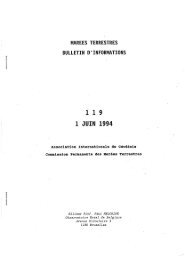marees terrestres bulletin d'informations - Université de la Polynésie ...
marees terrestres bulletin d'informations - Université de la Polynésie ...
marees terrestres bulletin d'informations - Université de la Polynésie ...
You also want an ePaper? Increase the reach of your titles
YUMPU automatically turns print PDFs into web optimized ePapers that Google loves.
100<br />
low<br />
frequencies<br />
earth ti<strong>de</strong> frequencies<br />
high<br />
frequencies<br />
Quotient of the gravity amplitu<strong>de</strong>s: SG / ET18<br />
10<br />
1<br />
0.1<br />
0.01<br />
0.001<br />
0.0001 0.001 0.01 0.1 1<br />
Frequency [cph]<br />
Fig. 3: Transfer function between the ET18 gravimeter and the SG gravimeter<br />
over the whole frequency range.<br />
3600<br />
Gravity amplitu<strong>de</strong> [nm/s²]<br />
3200<br />
2800<br />
2400<br />
ET18<br />
SG<br />
Aug-07 Oct-07 Dec-07 Feb-08 Apr-08 Jun-08<br />
Fig. 4: Long-term drift of the ET18 gravimeter and the SG gravimeter. Both<br />
records contain waves with periods longer than 28 days.<br />
4. Analysis of the Earth ti<strong>de</strong> frequency ranges<br />
The Earth ti<strong>de</strong> bands inclu<strong>de</strong> waves with periods between 8 hours and 28 days. With the Earth ti<strong>de</strong> data processing<br />
package ETERNA34, the preprocessing and analysis of Earth ti<strong>de</strong> observations, the prediction of Earth ti<strong>de</strong> signals<br />
and the computation of ocean ti<strong>de</strong> loading are possible. The adjustment of the tidal parameters is based on the least<br />
squares method. Results are the amplitu<strong>de</strong> factors δ and phase differences α. The amplitu<strong>de</strong> factors δ for the tidal<br />
wave groups are calcu<strong>la</strong>ted by the equation:



